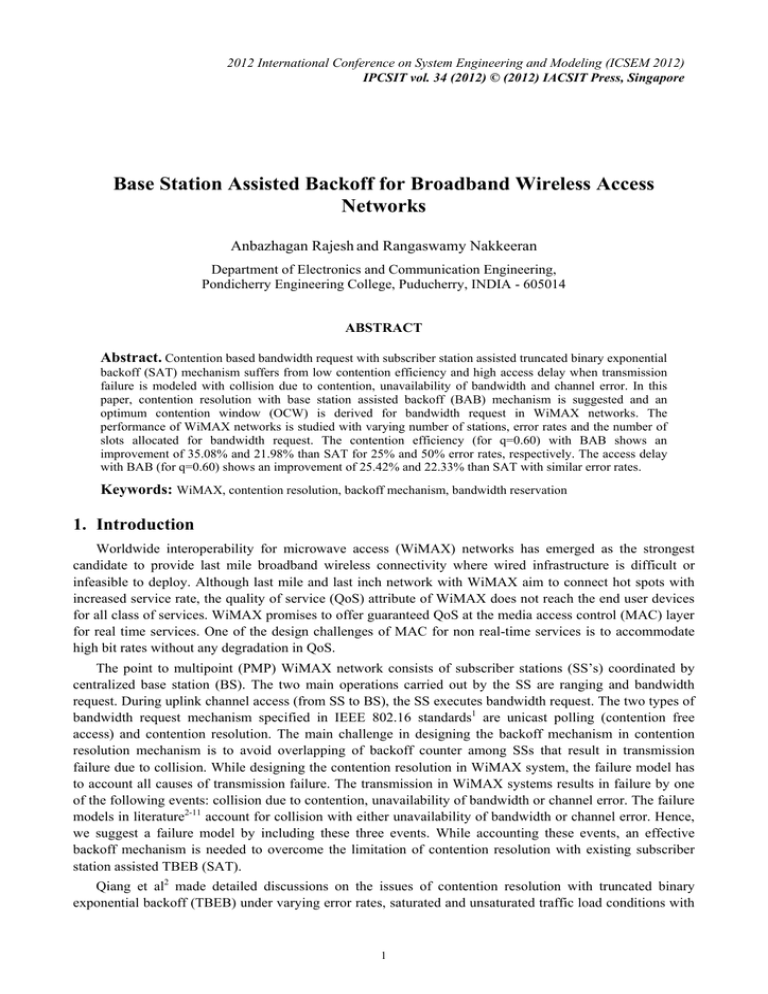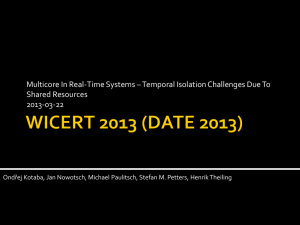Base Station Assisted Backoff for Broadband Wireless Access Anbazhagan Rajesh
advertisement

2012 International Conference on System Engineering and Modeling (ICSEM 2012) IPCSIT vol. 34 (2012) © (2012) IACSIT Press, Singapore Base Station Assisted Backoff for Broadband Wireless Access Networks Anbazhagan Rajesh and Rangaswamy Nakkeeran Department of Electronics and Communication Engineering, Pondicherry Engineering College, Puducherry, INDIA - 605014 ABSTRACT Abstract. Contention based bandwidth request with subscriber station assisted truncated binary exponential backoff (SAT) mechanism suffers from low contention efficiency and high access delay when transmission failure is modeled with collision due to contention, unavailability of bandwidth and channel error. In this paper, contention resolution with base station assisted backoff (BAB) mechanism is suggested and an optimum contention window (OCW) is derived for bandwidth request in WiMAX networks. The performance of WiMAX networks is studied with varying number of stations, error rates and the number of slots allocated for bandwidth request. The contention efficiency (for q=0.60) with BAB shows an improvement of 35.08% and 21.98% than SAT for 25% and 50% error rates, respectively. The access delay with BAB (for q=0.60) shows an improvement of 25.42% and 22.33% than SAT with similar error rates. Keywords: WiMAX, contention resolution, backoff mechanism, bandwidth reservation 1. Introduction Worldwide interoperability for microwave access (WiMAX) networks has emerged as the strongest candidate to provide last mile broadband wireless connectivity where wired infrastructure is difficult or infeasible to deploy. Although last mile and last inch network with WiMAX aim to connect hot spots with increased service rate, the quality of service (QoS) attribute of WiMAX does not reach the end user devices for all class of services. WiMAX promises to offer guaranteed QoS at the media access control (MAC) layer for real time services. One of the design challenges of MAC for non real-time services is to accommodate high bit rates without any degradation in QoS. The point to multipoint (PMP) WiMAX network consists of subscriber stations (SS’s) coordinated by centralized base station (BS). The two main operations carried out by the SS are ranging and bandwidth request. During uplink channel access (from SS to BS), the SS executes bandwidth request. The two types of bandwidth request mechanism specified in IEEE 802.16 standards1 are unicast polling (contention free access) and contention resolution. The main challenge in designing the backoff mechanism in contention resolution mechanism is to avoid overlapping of backoff counter among SSs that result in transmission failure due to collision. While designing the contention resolution in WiMAX system, the failure model has to account all causes of transmission failure. The transmission in WiMAX systems results in failure by one of the following events: collision due to contention, unavailability of bandwidth or channel error. The failure models in literature2-11 account for collision with either unavailability of bandwidth or channel error. Hence, we suggest a failure model by including these three events. While accounting these events, an effective backoff mechanism is needed to overcome the limitation of contention resolution with existing subscriber station assisted TBEB (SAT). Qiang et al2 made detailed discussions on the issues of contention resolution with truncated binary exponential backoff (TBEB) under varying error rates, saturated and unsaturated traffic load conditions with 1 grouping and non-grouping schemes. Yaser et al3 presented an accurate analytical model for bandwidth request in WiMAX network and calculated the capacity of the contention slots in delivering bandwidth requests. In literature, several researchers2-10 carried out contention resolution with SAT. Nevertheless, there is need for robust backoff window estimation in WiMAX due to the type its accessing mechanism. Unlike wireless local area network (WLAN), the SS in WiMAX does not use carrier sense multiple access over collision avoidance (CSMA/CA) before transmitting a request. Further, the computation of optimum contention window by accounting the number of stations is very challenging with SAT. Wenyan et al11 have proposed base station coordinated backoff to overcome the limitations of SS assisted backoff. However, the authors have considered the failure due to collision alone. Hence, we aim to propose a base station assisted backoff by considering all the three events of transmission failure and derive the optimum contention window accordingly. The rest of the paper is organized as follows: The failure models, contention resolution with the proposed BS assisted backoff are presented in Section 2. Simulation results of the proposed and existing schemes are given in Section 3. Finally, concluding remarks is given in Section 4. 2. Proposed Contention Resolution in WiMAX network 2.1 Unified failure model The probability of failure of the WiMAX system can be characterized by three possible events namely: collisions due to contention, unavailability of bandwidth and channel error. Qiang et al2 modeled the probability of failure (Pf) with collision and channel error. According to them, Pf is given by: (1) P f = Pc + Pe − Pc Pe where Pe denotes the probability of error due to channel, Pc denotes the probability of collision due to contention. Yaser et al3 and David et al4 modeled the probability of failure with collision and unavailability of bandwidth and hence it is given by: Pf = Pc + (1 − Pc )(1 − q ) Tr (2) where q denotes the probability of BS to accept a bandwidth request and Tr denotes response time or waiting time. However, to the best of our knowledge in WiMAX network, the transmission failure has not been modeled with all three events. Hence, by assuming the events as mutually exclusive, we model the Pf in the proposed system as follows, Pf = Pc + (1 − Pe )(1 − Pc )(1 − q ) r + Pe T (3) In this paper, the performance of contention resolution mechanisms in WiMAX network is performed with the developed failure model in (3). The backoff counter in conventional truncated binary exponential backoff (TBEB) is decremented without accounting the status of the channel or number of stations in the network. This increases the chance of overlapping of backoff counter among the stations that leads to high probability of collision with TBEB. The performance of TBEB degrades further under the developed failure model given in (3). In TBEB, the backoff counter depends only on probability of collision. Nevertheless, the backoff counter has to be varied if transmission failure is due to unavailability of bandwidth or channel error. The contention resolution with TBEB suffers from low contention efficiency and high access delay. Hence, an effective contention mechanism is required to improve the performance of WiMAX network. 2.2 Proposed base station assisted backoff (BAB) To overcome the limitations of SAT with the developed failure model, base station assisted backoff (BAB) is considered in the proposed system for bandwidth request. In BAB, the contention window size to be chosen by the SS is broadcasted by the BS. On receiving the contention window, the SS will randomly choose their respective backoff counters. The advantage of choosing BAB over SAT is the estimation of optimum contention window (OCW) by the BS. The purpose of OCW is to avoid overlapping of backoff counter by accounting all causes of transmission failure. The OCW improves the contention efficiency with reduced access delay of the SSs. The contention process in WiMAX network is not started until uplink channel descriptor (UCD) is received. The BS transmit UCD message at a periodic interval in order to define 2 the characteristics of an uplink physical channel. The UCD message present in downlink subframe contains uplink transmit parameters and it is broadcasted by the BS. The choice of minimum contention window (CWmin) and maximum contention window (CWmax) by the BS, gives much flexibility in controlling the contention resolution. The SS set the maximum number of retransmission attempts from CWmin and CWmax. The BAB mechanism for bandwidth request is shown in Figure 1. The contention resolution algorithm with BAB works as follows. Figure 1. Proposed base station assisted backoff for bandwidth request When an SS has information to send and wants to start the contention resolution process, it sets its internal backoff window equal to the initial contention window defined in the UCD message. The SS randomly selects a number within this backoff window. The obtained random value indicates the number of contention transmission opportunities that the SS will defer before transmitting. An SS considers only the contention transmission opportunities for which this transmission would have been eligible. The SS transmits its bandwidth request when its backoff counter reduced to zero. If the SS does not receive any response from the BS after a specific duration of time, it assumes loss of request and waits for the consecutive optimum contention window from the BS. The BS computes optimum contention window as derived in subsection 2.3. The optimum contention window is broadcasted over every frame and the SS will update its contention window when the waiting time expires. The waiting time is the time over which the SS waits for response from base station after executing the bandwidth request. Unlike TBEB, that set constant contention window on collision, the SSs with BAB are updated with optimum contention window from BS. 2.3 Estimation of optimum contention window The contention efficiency (Ps) is the probability that a transmission opportunity containing a successful bandwidth request. The Ps, in the proposed system, is computed by accounting the channel error, unavailability of bandwidth and collision and hence it can be expressed as follows, Ps = N c P (1 − P ) N c −1 (1 − Pe ) (1 − (1 − q ) Tr ) (4) where Nc refers to the number of contending stations and P refers to probability of transmission. The main challenge in BAB mechanism is the computation of optimum contention window (OCW). An appropriate value of this contention window reduces the overlapping of backoff counter between SSs. The value of average contention window ( W ) is computed from the estimation of contention window size with maximum backoff stage ‘m’. The W is derived as follows, (1 − P ) (1 − (δ P ) ) (1 − P ) (1 − (δ P ) ) m W =W 3 f m f f f (5) where δ and W correspond to initial backoff factor and initial contention window size, respectively. The geometric probability distribution is considered in the proposed system. Therefore, the average value of contention window is given by the expected value of random variable. Thus, the probability of transmission (P) with average contention window becomes, P =2/ W and is given by, P= 2 (1 − Pfm ) (1 − δ Pf ) ( W (1 − Pf ) 1 − (δ Pf ) m (6) ) The OCW is computed by substituting the value of P in (4), differentiating with respect to W and equating to zero. The resultant contention window is given by: Wopt = N c 2 (1 − δ Pf ) (1 − Pfm ) (1 − P ) (1 − (δ P ) f f m if Pf <1 ) (7) The Wopt is broadcasted to all the SS on frame basis. The BS computes Wopt with the instantaneous value of probability of failure that is resultant of channel state information from SSs. The contention efficiency and hence the throughput of WiMAX depends on the value of Wopt. The Wopt not only consider the number of contenting station but also the events that cause the transmission failure. Hence, the proposed method effectively resolves contention with increase in number of stations and diverse channel conditions. 3. Simulation Results The contention based bandwidth request schemes with SAT and BAB has been implemented in Matlab to verify the proposed analytical model and compare the performances of the schemes. Simulation results are obtained by averaging over 15 runs and each run with 105 iterations. The following data are considered for this simulation. The duration of frame is 5 ms, the number of contention slots within a physical frame for bandwidth request is 16, minimum contention window is 8, initial value of waiting time (response time) is 8 and maximum number of backoff stage is 6. In addition, the MAC parameters are configured in accordance with the standard1. The system performance is evaluated in terms of contention efficiency and access delay by varying the contending stations for different values of q, namely 0.25, and 0.60. In addition, all simulations are carried out considering error prone channel for the system with 25% and 50% error rates. (a) (b) Figure 2. Contention efficiency under varying number of contending stations (a) 25% channel error and (b) 50% channel error (SAT - SS assisted TBEB, BAB – Base station assisted backoff) Figure 2(a) shows the contention efficiency of bandwidth request mechanism with 25% error rate. The contention efficiency increases with increase in the number of stations, q and attains saturation. The contention efficiency for BAB at this saturation region lies between 0.285 and 0.335 for q values of 0.25 and 0.60, respectively. Further, contention efficiency SAT lies between 0.224 and 0.248 for q values of 0.25 and 0.60, respectively. It is also evident that SAT performs better than BAB does when number of stations in the network is less than or equal to 15. However, with increase in number of stations greater than or equal to 20, the BAB performs better than SAT. The BAB shows an improvement of 27.23% and 35.08% than SAT for q values of 0.25 and 0.60 respectively with 25% error rate. Simulations carried out with 50% error rate is 4 shown in Figure 2(b), in which, contention efficiency lies between 0.258 and 0.283 for BAB, whereas it lies between 0.186 and 0.232 for SAT. The BAB shows an improvement of 38.70% and 21.98% than SAT for q values of 0.25 and 0.60 respectively. (a) (b) Figure 3. Access delay under varying number of contending stations with (a) 25% channel error and (b) 50% channel error. The access delay of contention based bandwidth request with 25% error rate is shown in Figure 3(a). The access delay increases with BAB when number of stations is less than 20. The increased access delay results from reduced contention efficiency that results in larger retransmission. The access delay of the system with SAT is 6.8401 ms and 5.8830 ms for the q value of 0.25 and 0.60 respectively, when number of stations equals to 50, whereas the delay is reduced to 5.0600 ms and 4.3873 ms with BAB. The proposed system shows an improvement of 26.02% and 25.42% for the q value of 0.25 and 0.60 respectively than conventional system with SAT. Simulations are repeated with 50% error rate and the results are shown in Figure 3(b). The access delay of the system with SAT is 7.2638 ms and 6.4150 ms for the q value of 0.25 and 0.60 respectively. The delay is reduced to 5.4213 ms and 4.9819 ms in the case of proposed BS assisted backoff. The proposed system shows an improvement of 25.36% and 22.33% in access delay with 50% channel error. 4. Conclusion In this paper, a contention resolution mechanism using base station assisted backoff (BAB) has been suggested. The BAB is investigated under failure model with collision due to contention, channel error and unavailability of bandwidth. The results are compared with conventional subscriber station assisted TBEB. Simulation results show that the proposed BAB scheme performs better than the conventional SAT scheme for varying error rates. 5. References [1] IEEE Standard for Local and Metropolitan Area Networks Part 16: Air Interface for Broadband Wireless Access Systems, C1-2004 (2009). [2] Qiang Ni, Ling Hu, Alexey Vinel,Yang Xiao, and Marios Hadjinicolaou, “Performance Analysis of Contention Based Bandwidth Request Mechanisms in WiMAX Networks”, IEEE Systems Journal, 4(4) , 477 – 486 (2010). [3] Yaser Pourmohammadi Fallah, Farshid Agharebparast, Mahmood R. Minhas, Hussein M. Alnuweiri, and Victor C. M. Leung, “Analytical Modeling of Contention-Based Bandwidth Request Mechanism in IEEE 802.16 Wireless Networks”, IEEE Transactions On Vehicular Technology, 57(5), 3094 – 3107 (2008). [4] David Chuck, Kuan-Yu Chen, and J. Morris Chang, “A Comprehensive Analysis of Bandwidth Request Mechanisms in IEEE 802.16 Networks”, IEEE Transactions on Vehicular Technology, 59(4), 2046-2056 (2010). [5] Amir Esmailpour and Nidal Nasser “Dynamic QoS-Based Bandwidth Allocation Framework for Broadband Wireless Networks”, IEEE Transactions on Vehicular Technology, 60(6), 2690-2700 (2011). [6] Young Ik Seo and Dan Keun Sung, “Adaptive Real-Time Polling Service for On-Line Gaming Traffic in IEEE 802.16e/m System”, IEEE Communications Letters, 14(10), 987-989 (2010). 5 [7] Qiang Ni and Ling Hu, “An Unsaturated Model for Request Mechanisms in WiMAX”, IEEE Communications Letters, 14(1), 45-47 (2010). [8] Yi Sun, Yilin Song, Jinglin Shi and Eryk Dutkiewicz, “Research on Bandwidth Reservation in IEEE 802.16 (WiMAX) Networks”, IEEE Telecommunications and Malaysia International Conference on Communications, 638 – 643 (2008). [9] Delicado J, Delicado F.M, Orozco-Barbosa L and Qiang Ni “Adaptive Contention Resolution Procedure for Emerging WiMAX Networks”, Wireless and Mobile Networking Conference (WMNC), 1-6 (2010). [10] Shih-Fan Chou, Jen-Hsi Liu, Hsi-Lu Chao, Tzu-Chi Guo, Chia-Lung Liu and Feng-Jie Tsai “Performance Enhancement of Contention-Based Bandwidth Request Mechanism in IEEE 802.16 WiMAX Networks”, IEEE 21st International Symposium on Personal Indoor and Mobile Radio Communications (PIMRC), 1287 – 1292 (2010). [11] Wenyan Lu, Weijia Jia, Wenfeng Du and Lidong Lin, “A Base Station-Coordinated Contention Resolution for IEEE 802.16 PMP Networks”, Springer, LNCS 4159, 605 – 614 (2006). 6





